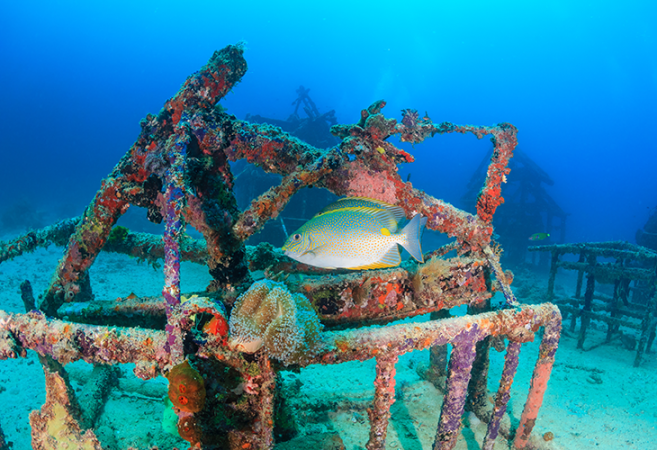Ocean energy could be the wave of the future
Wave-power systems are the latest in clean, renewable energy
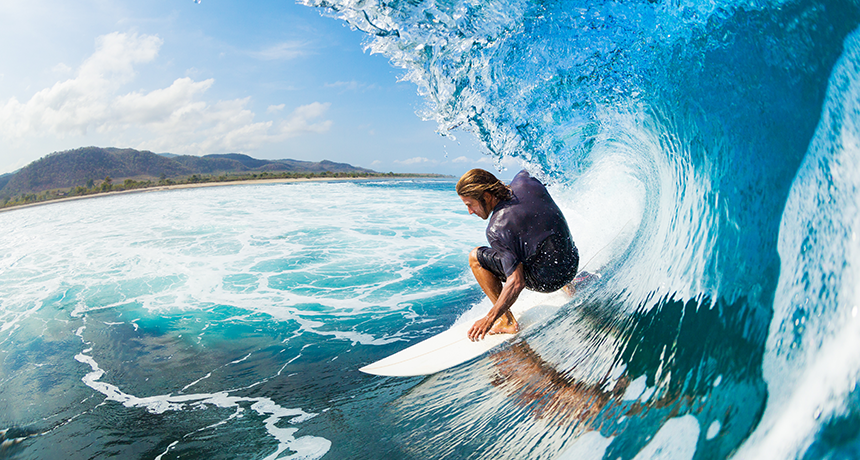
Not just great for surfing, waves may be the next big thing in renewable energy.
EpicStockMedia/iStock/Getty Images Plus
If the term “renewable energy” brings to mind a sea of solar panels or towering wind turbines, you’re not alone. It’s becoming more and more common to capture energy from the sun and wind. That’s because these “clean” energy sources generate electricity without polluting our air. Just as important is that they don’t release carbon dioxide into the atmosphere. That greenhouse gas traps the sun’s heat and contributes to our changing climate.
But solar and wind power have one big downfall: They’re not always available. The sun only shines during the day. Wind comes and goes. There are very few places where wind is constant enough to generate electricity all the time. And as easy as it sounds, storing energy for later use has proven a major challenge.
But ocean waves? As anyone who’s stayed near a beach can tell you, waves crash onto shore morning, noon and night. And that makes them ideal for generating energy around the clock. Now scientists are figuring out just how much energy waves could offer.
When wind blows across the surface of water, it creates waves. If you’ve ever seen white caps on an ocean or some lake on a windy day, you’ve seen this in action. The wind causes water at the surface to bob up and down. Even though it seems as though the water is traveling from one place to another, it doesn’t actually go very far. Rather, it moves in circles — up, up, up to the top of the wave, then down, down, down the other side.
That’s true, at least, when the water is very deep, such as out in the ocean. Those gently bobbing waves are called “swells.” But waves change when they get close to shore.
As the water gets shallower, it can’t travel in circles anymore. The ground gets in the way. The water bumps up against the ocean floor, squashing the circle into an oval. Much like a person tripping over something, the water “trips” over the ground. The top part lurches past the bottom. The wave “breaks,” crashing closer to the beach.
Wave energy systems use the water’s movement to make electricity. Some types of these devices harness the power of breaking waves. Others make use of swells. Still others use the pressure of waves near the ocean floor. Yet all have the same goal: Convert wave energy into electrical energy. That electricity can be used to power the electric grid. That’s the network of cables that transmits electricity to homes and buildings so we can use it.
Wave power is restricted to areas near the ocean. After all, the cables that carry electricity can only be so long. But 40 percent of the world’s population lives within 100 kilometers (60 miles) of the ocean. That means a whole lot of lights, TVs and tablets could be powered by waves.
With all that promise for wave power, researchers are testing how well different types of generators convert ocean energy to electricity. Along the way, they’re trying to make sure that sea life won’t be harmed in the process.
Power where it’s needed
The first step to creating wave power? Figuring out the best place to put those energy converters.
Not all coastal areas work for generating wave power. The shape of the land beneath the sea changes the size and shape of waves. Wave-energy converters also are costly. The best spots should have plenty of wave action, but not so much that converters might be damaged in a storm.
To figure out the best sites, scientists turn to computer models. Joao Morim Nascimento and Nick Cartwright are environmental engineers in Australia. Both work at Griffith University in Southport, Queensland. An environmental engineer works to reduce pollution and waste. The pair wanted to find good places for wave-energy converters along their country’s southeast coast. It’s home to several large Australian cities. Since so many people live near the coast, this area could be great for wave power.
The researchers started out with an existing computer model called SWAN. (That name stands for Simulating WAves Nearshore.) SWAN was developed by researchers at the University of Delft in The Netherlands. It predicts the strength and location of ocean-wave energy. To do so, it factors in things like wind, features on the ocean floor and interactions among multiple waves.
Morim Nascimento and Cartwright adapted SWAN to apply to southeast Australia. They added details about the water’s depth out to within 50 kilometers (31 miles) from shore. They also put in data on the region’s winds and waves. Then they tested the model using data from buoys in the ocean. The engineers tweaked the model until it closely predicted the amount of wave energy being recorded by the buoys.
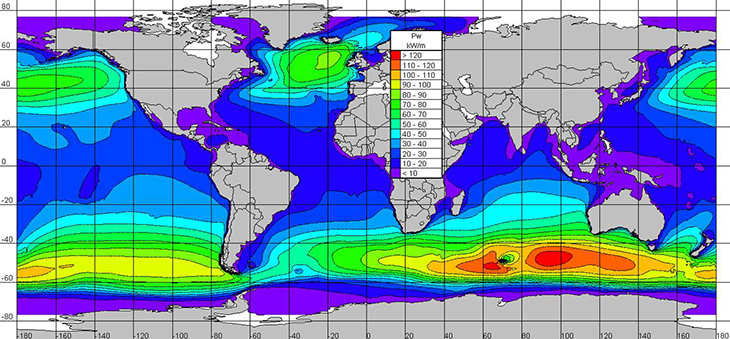
The model helped the team find “hotspots” — places with what Cartwright describes as an “abundance of wave energy.” Each site is within 5 kilometers (3 miles) of shore in water no more than 22 meters (72 feet) deep. These are ideal, he explains, because it is easier and cheaper to get the power to shore from these sites than it would be from farther out.
“There is more than enough natural energy there in the ocean,” he says. “The challenge is to harness and convert enough of it into power” that people can use. Part of that challenge is the ocean itself. Waves constantly pound at the equipment. The hardware also can experience some extreme weather. Very large storm waves can damage the converters, Cartwright says. And, he adds, salty seawater corrodes, or breaks down, any metal parts.

Sea carpet
Scientists and engineers are trying lots of different ways to overcome these challenges. Their ideas have led to many types of designs. Some converters float on the surface, tethered to wave-generators on the ocean floor. Others have one end anchored to the sea bottom with the other free to flip from side to side as waves wash over it. Still others use air or water pressure to generate electricity.
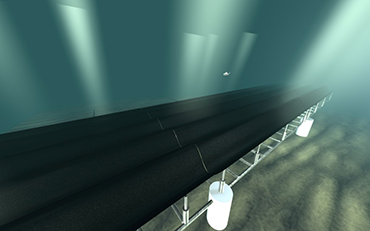
One of the newest systems looks a bit like a flat carpet. Mohammad-Reza Alam and his team at the University of California, Berkeley designed the converter to mimic a muddy seafloor. Places with lots of mud are good at absorbing incoming waves, Alam explains. Fishermen in shallow seas often head for muddy areas when rough weather hits. Boats hanging out there are protected from big waves as they ride out a storm.
If mud can absorb that much energy, Alam reasoned, then an energy converter that acts like mud should do the same. That would make it extremely efficient at harvesting wave power.
The “carpet” part of his converter is made from a smooth sheet of rubber. It rests near the seafloor, where it can bend and flex right along with the waves. As it moves up and down, it pushes posts in and out of a piston pump. The pump converts the piston’s movement into electricity, which then travels along a cable to the electric grid.
The carpet is able to remove almost all of the energy from the waves, Alam says. And it would be able to power lots of homes. Each hour, he says, “every square meter of the carpet can get about 2.5 kilowatts [of electricity] out of water near the coast of California.” That’s twice the amount of electricity used each hour by a typical American home
UC Berkeley/YouTube
“If we want to get the same power from solar,” Alam says, “we need 14 square meters [151 square feet] of solar panels.” That’s 14 times as much! He says a full-size wave carpet would probably be about 10 meters (33 feet) wide by 20 meters (66 feet) long. So it should be able to generate 500 kilowatts of electricity per hour — enough to power more than 400 homes — around the clock.
Other locations, such as northern Europe, have more energetic waves. So a wave carpet there could generate more electricity, Alam notes. On the flip side, weaker waves in places like the Gulf of Mexico couldn’t pump as much electricity into the electric-power grid.
Anchored to the sea floor, the whole structure lies just above the seabed. So it’s completely out of sight. That’s important to many people who spend time at the beach. They don’t like to see big energy-generating structures (like wind turbines) when they’re out for a swim or sail. In fact, many wind farms are located far from shore, so that people enjoying the beach don’t see them. The wave carpet, however, can be close to shore. That means the cables that carry electricity to the grid can be much shorter. And the electricity generated by the carpet should therefore cost less.
Good for the environment?
There’s no question that finding new sources of renewable energy is good for the environment. Less pollution and fewer greenhouse gases are good for people, plants and animals. But clean energy sources can still cause problems.
Wind turbines can get in the way of migrating birds and bats, for example. (Some estimates say hundreds of thousands of these animals may die each year from collisions with the massive spinning blades.) The lower height of wave-energy converters means they probably wouldn’t interfere with migrating animals. But “we do need to consider their interaction with the marine environment carefully,” says Deborah Greaves. She is an ocean engineer at the University of Plymouth in England.
One concern is about any ecological impacts of absorbing all of that energy from incoming waves. (After all, that’s how they generate electricity — by converting wave energy into electrical energy.) Energy tapped from the waves will reduce how much energy will remain as the waves continue in toward shore. They will be smaller, at least for some distance. Smaller waves could lead to less mixing of nutrients within the water column (that’s the water between a particular bit of ocean bottom and the surface above it). And that could impact with species that live there, Greaves says. “But it can also be a benefit,” she adds. After all, “wave-energy converters can help provide some coastal protection” by reducing erosion.
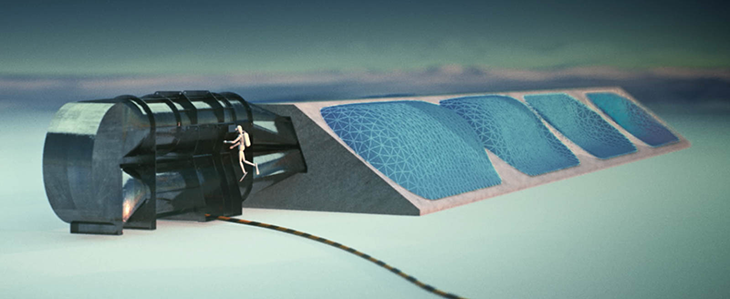
The electric generators also could affect how wildlife interact. Many birds and marine mammals hunt for fish in areas that might be ideal sites for wave converters. It’s possible that converters could even attract fish to them if the smaller critters they eat seek refuge there. That could, in turn, attract hungry predators. This might help boost marine life in the area. But fish, seals and other animals might also get tangled up in long cables that anchor surface-floating energy converters. So researchers must study where they want to install these converters to make sure they won’t harm local ecosystems.
Another concern: The converters will make noise. This can be a problem for fish, dolphins and other animals that rely on sound to find food or to communicate. The deep rumble of a boat and the loud ping of sonar cause all kinds of problems for ocean animals. These critters may struggle to find food or become disoriented. However, Greaves says, wave converters are unlikely to create high levels of noise. The noisiest part would happen when the converters are initially installed at some site. Once they start running, they should be fairly quiet.
On the plus side, converters might become the base for an artificial reef if algae, mussels, barnacles or corals take hold of the structure and begin to grow. Such reefs provide protection for fish and other marine life. That could increase the diversity of marine life in the area. They could be helpful, as long as those critters don’t interfere with the wave converter’s movement.
“From the vast resources of the ocean, wave energy has the potential to make a huge contribution towards our clean energy needs of the future,” Greaves says. But, she cautions, it “needs to be done in a sustainable way, in harmony with the marine environment.”
